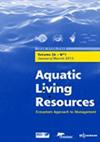Real Time PCR detection of Macrobrachium rosenbergii (de Man, 1879) larvae with emphasis to their ecology
IF 1.9
4区 农林科学
Q3 FISHERIES
引用次数: 0
Abstract
Species specific identification of early larval stages of many decapod crustaceans sampled from plankton collections remains cumbersome owing to lack of distinguishable characteristics, where DNA based molecular methods provide accurate results without taxonomic ambiguities. In the present study, an attempt was made to detect temporal occurrence of early zoea of freshwater prawn Macrobrachium rosenbergii (de Man) using real-time PCR assays in polyhaline, mesohaline and oligohaline areas of a tropical positive estuary, the Vembanad lake (S. India). High caridean larval abundance could be recorded in polyhaline areas in all seasons while it could be recorded in monsoon season in mesohaline and oligohaline areas. 113 DNA isolations were successfully made from morphologically identified taxonomic units (MOTU) and SYBR Green based RT-PCR amplifications using designed primer for M. rosenbergii yielded positive detections in 38 samples (34%) representing all seasons in all three zones. Positive detections could be recorded in all months except May in mesohaline areas and differed significantly (F = 17.2 p < 0.01) with the same in polyhaline and oligohaline areas. The present results of molecular detection of M. rosenbergii larvae extend confirmation of its breeding ground in Vembanad lake where appropriate management strategies could be enforced for stock conservation of this species.
罗氏沼虾(Macrobrachium rosenbergii, de Man, 1879)幼虫的实时荧光定量PCR检测及其生态学研究
由于缺乏可区分的特征,从浮游生物收集的样本中对许多十足甲壳类动物的早期幼虫阶段进行物种特异性鉴定仍然很麻烦,其中基于DNA的分子方法提供了准确的结果而没有分类歧义。在本研究中,利用实时荧光定量PCR技术,在热带河口Vembanad湖的多盐、中盐和低盐区检测罗氏沼虾(de Man)早期藻的发生时间。多盐区四季均有较高的鲤鱼幼虫丰度,中盐区和低盐区在季风季节均有较高的鲤鱼幼虫丰度。从形态学鉴定的分类单位(MOTU)中成功分离出113个DNA,使用设计的引物对罗氏分枝杆菌进行基于SYBR Green的RT-PCR扩增,在38个样本(34%)中检测出阳性,代表了所有三个地区的所有季节。中盐区除5月份外,其余月份均有阳性检测,差异有统计学意义(F = 17.2 p <;0.01),多卤区和低卤区差异无统计学意义。本文对罗氏沼虾幼虫的分子检测结果进一步证实了其在Vembanad湖的繁殖地,为该物种的种群保护提供了合理的管理策略。
本文章由计算机程序翻译,如有差异,请以英文原文为准。
求助全文
约1分钟内获得全文
求助全文
来源期刊

Aquatic Living Resources
农林科学-海洋与淡水生物学
CiteScore
2.30
自引率
0.00%
发文量
10
审稿时长
>24 weeks
期刊介绍:
Aquatic Living Resources publishes original research papers, review articles and propective notes dealing with all exploited (i.e. fished or farmed) living resources in marine, brackish and freshwater environments.
Priority is given to ecosystem-based approaches to the study of fishery and aquaculture social-ecological systems, including biological, ecological, economic and social dimensions.
Research on the development of interdisciplinary methods and tools which can usefully support the design, implementation and evaluation of alternative management strategies for fisheries and/or aquaculture systems at different scales is particularly welcome by the journal. This includes the exploration of scenarios and strategies for the conservation of aquatic biodiversity and research relating to the development of integrated assessment approaches aimed at ensuring sustainable and high quality uses of aquatic living resources.
 求助内容:
求助内容: 应助结果提醒方式:
应助结果提醒方式:


